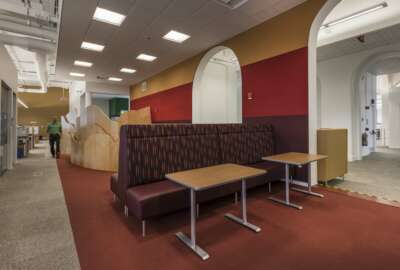GSA to agencies: Want more money for office space projects, think small
Within the omnibus spending package is a directive for agencies that states their consolidation plans will get preference for funding if they include shrinking...
An average coffee shop offers customers about 13 square feet of space to work.
The federal government is offering a bit more wiggle room for agencies to consolidate their workspaces, but according to the fiscal 2016 spending bill, the smaller the better.
Within the Consolidated Appropriations Act of 2016, the General Services Administration is set to get $75 million for consolidation activities, and “preference is given to consolidation projects that achieve a utilization rate of 130 usable square feet or less per person for office space.”
The directive is one of many included in the massive $1.1 trillion omnibus spending bill, which covers everything from hazardous waste to space travel to turtle conservation, and how the government will be funded for fiscal 2016 — which started Oct. 1.
Also included in the GSA’s directives on office space is the declaration that a diplomatic facility in the United States “may not include office space or other accommodations for an employee of a federal agency or department if the Secretary of State determines that such department or agency has not provided to the Department of State the full amount of funding required.”
The bill notes that a project of this kind may include office space or accommodations for the Marine Corps.
The bill also advises “none of the funds provided in this act may be used to increase the amount of occupiable square feet, provide cleaning services, security enhancements, or any other service usually provided through the Federal Buildings Fund, to any agency that does not pay the rate per square foot assessment for space and services as determined by the General Services Administration in consideration of the Public Buildings Amendments Act of 1972 (Public Law 92–313),” the legislation states.
Vivian Loftness, university professor and former head of the School of Architecture at Carnegie Mellon University, said 130 usable square feet “is not a terrible target.”
“There’s two ways to achieve it effectively,” she said. “Start to make everyone work in smaller spaces. The furniture industry is very creative in how to make a work station feel larger. The other way to achieve a sort of higher usability ratio for federal agencies is to start thinking about non-territorial offices.”
That means rather than assigning desks for everyone in the company, groups of desks could be assigned to divisions. Someone can sign in to a work station or desk for the day and perhaps personalize their work station with a rolling locker or cabinet, Loftness said.
“I’m assuming that at some point GSA helped to craft some of this wording, and probably intended it to be in their best interest,” Loftness said. “For congressional leaders, this is a way to save money in the federal sector. I can imagine that would make it a popular recommendation.”
GSA, in fact, has been looking at ways to improve and streamline the federal workspace for several years. According to a Workspace Utilization and Allocation Benchmark from July 2011, the private sector reported an average space per person of 200 usable square feet, with a median of 193 usable square feet. That’s compared to the federal benchmark of 190 usable square feet.
Earlier this year Federal News Radio reported on “federal offices of the future.”
Speaking with Federal Drive’s Tom Temin, GSA’s Director of the Office of Federal High-Performance Green Buildings Kevin Kampschroer and staff expert Judith Heerwagen said the major change that would be seen was a shift to a flexible environment like an open office.
“We’re going to see transformations so offices become more like a stage set, transforming for each stage of a project,” Heerwagen said. “We’re seeing organizations adopt a wide variety of models to support their individual missions. They’re more conscious of the workplace as a strategic value.”
Kampschroer said there has been some pushback about an open floor plan, but overall it’s a helpful layout.
“We did measurements at different cubicle heights and what we found was that, acoustically, when the partitions are low and you have visual connection with the other people in the space, the overall sound levels are measurably lower,” Kampschroer said. “People also say they learn things from accidental conversations in open space. Yes, it’s bothersome, but on the other hand yes, it’s useful. In one case study, 95 percent of the people said there weren’t enough conference rooms. But we also found that 70 percent of the time the conference rooms were empty.”
Loftness said government has the advantage of allowing people to telework and have flexible work schedules. Factoring in vacation time, sick days, conference leave and personal days, it’s rare that an office will always have everyone present on the same day — day in and day out.
“Rather than put in 100 seats [for a workforce of 70], why not put in 70 seats,” Loftness said. “That’s where you start to see smaller, overall usable square feet.”
Copyright © 2025 Federal News Network. All rights reserved. This website is not intended for users located within the European Economic Area.
Related Stories




